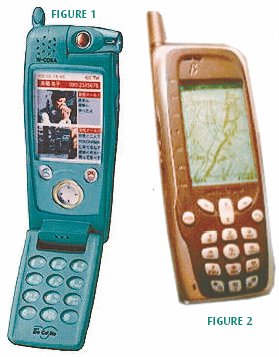
|
This article originally appeared in Geospatial Solutions Magazine's Net Results column of February 1, 2001. Other Net Results articles about the role of emerging technologies in the exchange of spatial information are also online. |
| 1. Introduction and Glossary 2. World Market 3. US Market 4. Future of LBS 5. Place in the Choir | |
| For me, a fervent believer in the power of geospatial technology, learning about the wireless and LBS markets has been like biting into a fat slice of humble pie. Take a moment to consider that there are more than six billion people in the world, of which we are all infinitesimal (though not insignificant) parts. Some claim that these billions of individuals are more alike than unalike. Indeed, for its success thus far, the wireless industry has relied on two universal human behaviors -- almost everyone talks, and almost everyone walks. Today, thanks to mobile phones, a walking person on one side of the globe can talk to a friend walking on the opposite side. Combine this simple idea of worldwide walking talkers with the world s population and it becomes clear that some of the hype about wireless communications really is justified. We are all potential customers of the wireless industry. Realizing this, a sobering collection of corporate giants are tumbling over themselves to corner a piece of the burgeoning wireless market and address such specific niches as LBS. LBS from birth to baptism We will all bear witness to the birth of LBS. Knowing where each person in the world is (or, at least, where their mobile devices are) and having a means of directly contacting them makes it possible to sell not just services, but to offer place-specific services. This could include the nearest restaurant, dispatching the closest taxi, or identifying the nearest theater that is showing the movie the user wishes to see. With such a simple concept, is it any wonder that corporations are scrambling to provide services to six billion potential LBS customers? A brief investigation of the companies that own and operate the mobile phone infrastructure reveals how busy they have been in the past five years. Ever-growing cellular networks exist in almost every region of the world. Each operator supports millions of customers from whom they generate billions of dollars in annual revenue. The mobile phones themselves, which cost more than $1,000 ten years ago, are now available for less than $200, or even for free. Approximately 300 million people worldwide now use mobile phones. That is, if you can still call them mobile phones. Is a device that draws maps, lists stock prices, and checks e-mail adequately described by the term mobile phone? Philippe Vander Putten, CEO of the Belgian telecommunications operator Proximus/Belgacom Mobile (www.proximus.be), sums up this morphing of mobile phone functionality when he says, "...a service that guides its users to their destination is a very good example of how mobile phones have evolved into much more than just means of communications; they are now sources of information and assistance to users wherever they are." The word service reveals the emerging change not just in the physical design of mobile devices, but in the cast of characters comprising the overall wireless industry. Thus far, the worldwide adoption of mobile phones has created two main revenue streams, one from the sale of the devices themselves, and the other from cellular network usage fees. Now a third cash tributary called services has joined the streams. This third stream flows from the idea that mobile devices connect their users not only to their friends, but also to useful (and not necessarily spoken) information. Mobile phones are just for talking, but mobile devices (see Figures 1 and 2) are for acquiring information -- When does my plane depart? What is my stock worth? How do I reach my destination? The term services describes both the supply and the suppliers of this useful information. |
 |
Figure 1: This Japanese CDMA phone prototype is capable of displaying color images and text via the Internet. Other prototypes are on display at www.theapplecollection.com/design/phone/NTT_DoCoMo.html. |
| Figure 2: A GSM/ GPS mapping phone introduced in 1999 by Benefon, a Finnish GSM and Nordic mobile telephone terminal vendor, cited from www.mobileipworld.com/wp/positioning.htm. |
| The opportunity to deliver services to mobile devices has attracted a wider range of players to the bountiful wireless market, all eager to share their information with individual device owners for a small monthly fee. The existing wireless players are willingly partnering with these new service providers, hoping that the handsets and networks offering the coolest services will become the most popular purchases (see A Place in the Choir sidebar). Services are nothing new. The Internet is a well-established service delivery system. Already, it is possible (some claim easy) to capture free information about plane schedules, stock prices, driving directions, and just about anything else from a few clicks in your trusty desktop computer's Internet browser. What is new, however, is that your desktop computer, its Internet browser, and its modem now fit (in abbreviated form) into that amazing handheld tool once called a mobile phone. And -- here's the spatial punch line -- before the end of 2001, this already incredible mobile device will also know its own location on Earth.
Glossary API: Application programming interface CDMA: Code-division multiple access E-OTD: Enhanced observed time difference E911: Enhanced 911 FCC: Federal Communications Commission GSM: Global System for Mobile Communications LBS: Location-based services PCS: Personal communications services PSAP: Public safety answering point |
| 1. Introduction and Glossary 2. World Market 3. US Market 4. Future of LBS 5. Place in the Choir |
|
|